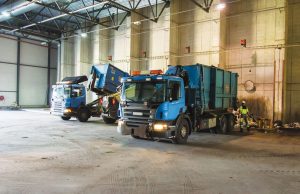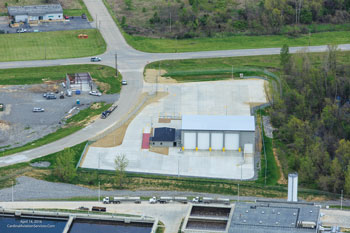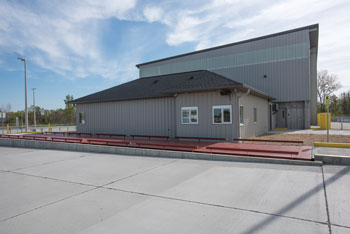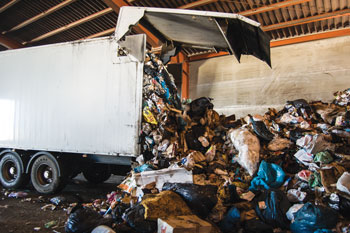How to keep your employees and any other individuals onsite at your transfer station as safe as possible.
By Evan Williams
Transfer stations are an integral part of the integrated management system for solid waste. They serve an important function in efficiently moving material to landfills or alternate disposal sites. While important in the role they plan, transfer stations can present challenging safety issues that should be addressed in a serious and dedicated manner. To better address the safety issues, they have been categorized with best practices for their elimination (or minimization). The categories will be based on the operation(s) in the building: onsite vehicle movement, scaling, unloading, loader operation and trucking.

Photos courtesy of Cambridge Companies.
Onsite Vehicle Movement
Transfer stations need to accommodate many different types of vehicles, most with vastly different levels of user experience and needs. Some users will be route truck drivers that come onsite several times each day, while some will be citizens who might be onsite once in their life.
Safety Risk: New site users do not know where to go/what to do.
Best Practice: Provide clear signage at the site entrance for added clarity. Color code the signs for new site commercial and citizen (residential) users for added clarity and make sure the signs are visible and easily seen.
Safety Risk: Crossing traffic can be a risk for vehicle accidents.
Best Practice: Avoid crossing traffic, especially for different vehicle types. Where crossing traffic is unavoidable due to site constraints, make the crossing perpendicular and ensure good sight lines. In addition, speed bumps, stop signs and flashers can ensure that the users stop and look prior to proceeding. The goal is to make it abundantly clear what all users are to do at any intersection. Uncertainty leaves open the possibility for accidents.
Safety Risk: Different vehicle types are interacting on the same site.
Best Practice: Design the site to have separate and clearly defined roads for the different vehicle types. Trucks entering the site to be loaded with material should have a separate or clearly defined path of travel apart from the vehicles arriving onsite to unload material. A separate circulation road may be necessary where significant in-bound material traffic is expected from individual citizens. By keeping these vehicles apart and moving in the same direction, accidents are minimized. Also, since the vehicles are all moving in the same direction, if impacts do occur, their magnitude should be less.

Scaling
Scales are important to transfer station operations. They allow the facility operators to monitor the weight and composition of the incoming material. This also represents the first interaction between the incoming material and facility operations staff. There are several safety risks that this operation can help address.
Safety Risk: Dangerous or unacceptable incoming material.
Best Practice: Intentional or not, it is not uncommon for incoming material to contain items that are not acceptable at the transfer station. What is acceptable/unacceptable will vary greatly from market to market, but mounting an overhead CCTV on a pole over the incoming vehicles will give the scale operators a chance to see what is in the load. If they see anything off, they can address it. In addition, transfer station inbound scales should be equipped with a radiation detector. These will flag loads with loads containing radiation-bearing materials.
Safety Risk: Unclear site understanding.

Best Practice: The scale operator has an opportunity to offer clear direction to the incoming material. Working in coordination with the loader operator and a spotter, they should be able to clearly direct the vehicle on the scale to a specific door on the transfer station. Have the doors labeled with large signage, and this will minimize the guesswork of where the user needs to go to unload their material.
Unloading
The unloading of incoming material streams presents some of the most serious safety risks on the site, as they are the only activity where people will be out of their vehicles. In addition, the more complex maneuvers required to get the vehicles into unloading position further complicate safe operations.
Safety Risk: Commercial versus public drop-off.
Best Practice: Where the site allows for it, the public should be unloading their loads at a different location from the commercial haulers. This can go directly into a roll-off in a facility adjacent to the transfer station, or it can be into the same building, but at different doors and ideally with a physical barrier preventing people from walking into the transfer station itself. This can be done with a guardrail or a chain. Provide good signage as well as floor striping to encourage proper activity. Better yet, when public drop-off is active, keep a spotter close to monitor the activity.
Safety Risk: Vehicle strike(s) on staff.
Best Practice: All OSHA regulations must be followed with respect to proper PPE, backup audible and light warnings. In addition to this, the building can be designed to encourage safety. The side of the transfer station where the vehicles back up to unload can have a series of doors or framed openings, rather than one large opening. This allows for clearly defined unloading positions instead of a free-for-all. This aligns with the scaling safety best-practice to assign unloading spots to vehicles when they scale in. From an operations standpoint, there can also be a prohibition on sumping out the trucks in the transfer station, but this is typically an unpopular option, as that then needs to be done at the hauling company.
Loader Operation
The loader operator is tasked with managing the material on the transfer station floor as well as the pacing of the transfer trailer loading. They are doing this all at the wheel of a large and heavy vehicle without great visibility. There are several loader-related best practices that can make this operation safer.
Safety Risk: Fall hazard(s) with push pits.
Best Practice: Push pits are a popular approach with high-volume facilities. They do present a difficult compliance risk associated with the fall hazard they present with their unprotected 14’+ loading opening. Lift and load pits with a depth of between 6′ and 8′ present a good balance of loading speed, ability to pack and distribute to load, and operate in a safe manner. One properly designed and operated lift and load pit can easily handle 1,000+ tons per day, making the need for a push pit, with its inherent safety risks hard to justify.
Safety Risk: Loader hitting personnel or vehicles
Best Practice: There are several approaches to help minimize this risk. There are several accessory packages for the loader that can provide rear-facing cameras as well as impact warnings for the loader operator. These should be evaluated on a case-by-case basis. In addition, the facility should be operated in such a way that the loader works on filling trucks in a separate area from where vehicles are unloading. Once the floor is clear, then the wheel loader can come and scrape the material away to the storage pile. Keeping the loader as far from the other vehicles is the goal.

Trucking
The trucking operation associated with hauling the material offsite does contribute to the overall site safety risks. From fire to fall hazards, understanding the risks associated with this task should guide actions to minimize those risks.
Safety Risk: Fall hazard while tarping.
Best Practice: In the site design, provide either a dedicated tarping rack that staff can safely climb to tarp their loads or ensure all trailers used onsite will use auto-tarpers. Note: the design and orientation of these should be coordinated with the facility design to not interfere with the trailer loading.
Safety Risk: Fire in loaded trailers stored overnight.
Best Practice: At many sites, facility operations require the transfer station floor be cleaned of material at the end of each day. With the last loads to the landfill leaving mid-day, this leaves a trailer that is loaded with material that needs to stay onsite until the next day. It is tempting to store this inside to keep it dry, as well as minimize the chance for wind to blow away material or odors to pass to adjacent properties. This should not be allowed under any circumstance. The material density in the trailers and the very real possibility of smoldering material or a chemical reaction in that load represent a perfect recipe for a fire. Once a fire is engaged enough to actuate the fire sprinklers in the building, those same sprinklers will not be able to extinguish that fire. Systems such as Fire Rover, which use thermal imaging, an actively managed command canter, and a remote-controlled fire-retardant foam cannon can address this risk before it is a full-scale fire. At a minimum, no un-sorted MSW material should be stored in an unoccupied facility.
Identify and Manage Risks
Nothing in life comes without risk, and transfer stations are no exception. While no two facilities are identical, they share common risks to be identified and managed. It is through identifying the likely safety risks and implementing proven and effective strategies to minimize them that we can best design and operate transfer stations that manage material in an effective and safe manner. | WA
Evan Williams is a Design Project Manager at Cambridge Companies (Griffith, IN), a design-build firm working with the waste industry for more than 20 years. During this time, over 100 solid waste design-build projects have been completed including new build, repairs, upgrades and/or modifications at transfer stations, recycling centers/MRFs, hauling companies, landfill facilities, office buildings and more. Cambridge continually monitors the industry to determine any new needs, changes or improvements that will benefit their clients and improve their design-build solutions. Evan can be reached at (219) 972-1155, via e-mail at [email protected] or visit www.CambridgeCoInc.com.
